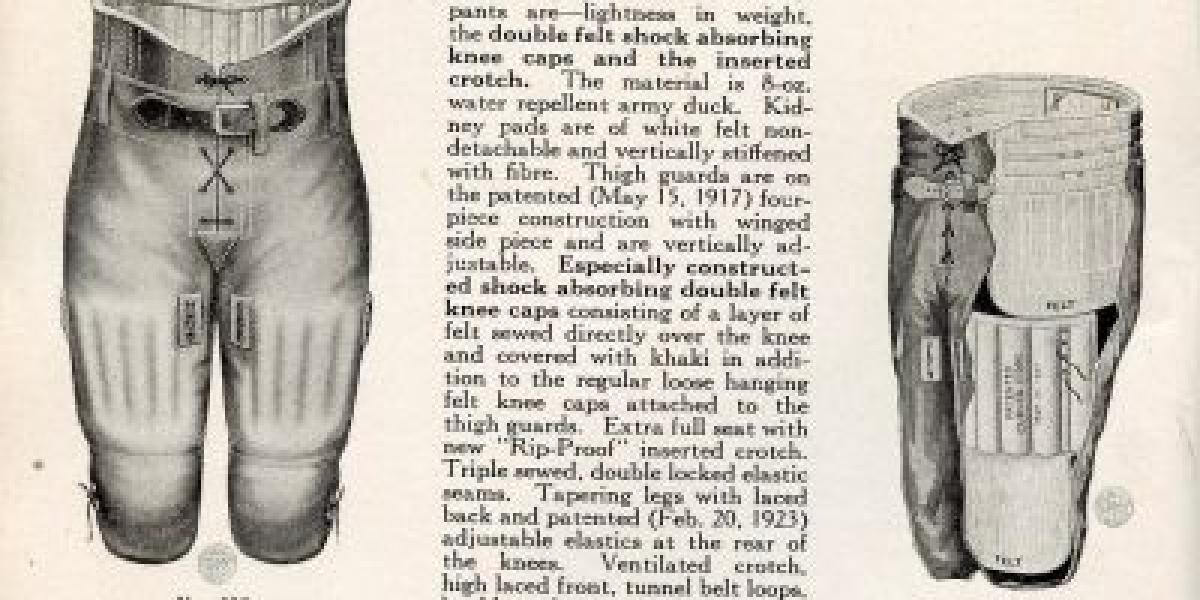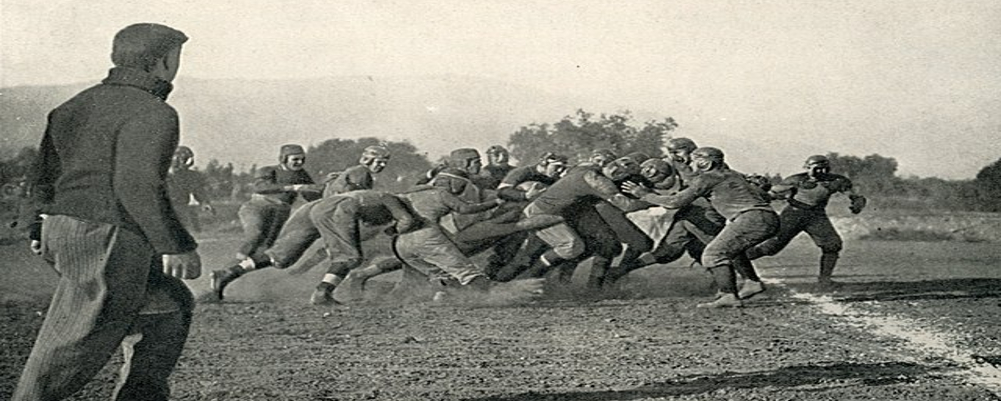Timothy P. Brown shares some history of the pants of gridiron players and their evolution over time.
Transcribed Conversation on Football Pants History with Timothy Brown
Hello, my football friends, this is Darin Hayes, PigSkinDispatch.com. Welcome once again to The Pig Pen, your portal to positive football history. Welcome to our Tuesday and our visit with Timothy P. Brown of FootballArcheology.com, where he shares one of his recent tidbits.
Tim, welcome back to The Pig Pen. And boy, you have a really interesting title tonight.
Well, hopefully more than just title, but hey, obviously good to see you again. Looking forward to chatting about disintegrating football pits.
Yeah, the title is very eye-catching and makes you really want to dig into it. But you're right. The content is where the meat of the soup is here.
And it's a great stew that you cooked up. And we're anxious to hear all about this story.
Yeah, so this one, you know, is part of what I do. I mean, you know, I get my information and ideas from a lot of different places.
However, one of the things that I do is acquire old sporting goods catalogs. And, you know, I'm only interested in the ones that have football sections in them. But, you know, I come across those.
So I've got a collection of, I don't know, 30, 40 old catalogs. And so, you know, I just use those to try to understand how pads and other kinds of equipment changed over the years. The technologies, the fabrics that they were, they were used, how they were designed, you know, how they were built and kind of how they pitched to me, you know, how, you know, how they marketed them.
Well, I'm glad you glad you told us why you got them for, because I'm picturing your mailman bringing back all this mail to you. Return to senders. You're trying to order these pants, you know, a football for five dollars from a 1907 catalog or something, the J5.
And so, you know, there's a couple of the catalogs I have that still have the order forms in them. So, you know, I've always been tempted to at least photocopy it and send it in to somebody and see, see what happens. But I don't think the addresses will work for me anymore.
Probably not. Probably not. But so are the disintegrating football pants.
It's, you know, deliberately. Misleading title because, you know, people think that the pants themselves disintegrate and disappear, but it's not it's not like a tearaway jersey where I meant disintegrating in the sense of disaggregating. So it was, you know, back when football pants were first used, when people were first playing football, they wore these, you know, kind of very light knit.
You know, you know, almost, you know, they almost like the tights that, you know, I know when I run in the winter, I'm wearing tights and women are wearing yoga pants. I mean, it's that kind of that kind of thing. And I bet you wear yoga pants sometimes, too, right? I can't share that information with you right now.
Well, let's go on back into the football. Let's go back to the football. OK, sorry, I asked.
But so after that, you know, they were first wearing these tights, but then once the game got rougher and kind of that, the whole mass and momentum thing happened, and then they started wearing these. They padded the pants. And if you look at the old-time photos, initially, the fronts were quilted, you know, quilted, you know, there was horse hair or felt that got quilted into the pads.
And then then, you know, at the turn of the century, they moved to a little bit more mechanical protection, especially the thighs. And they had done it with the shins before, but they had these ribs. It was basically pieces of cane that, you know, were sewn into the into the pants.
And then, you know, backed by felt, the knees would still have horse hair or felt pads. And then you finally got to a point in the late 1910s where they added, you know. Also, the pants got high-waisted. You know, they were protecting the hips and the kidneys.
So, you know, if you see some picture of a guy with, you know, it looks like the pads are going up to his armpits. You know, that's probably, you know, 1916 to 24, something that time period. But at the same time, they were adding those high hip, that high hip look.
People were, you know, football, and they were still going through this thing about speed, speed, speed. And so there were players who were basically cutting pads out of their pants. You know, they wanted to be as light as possible, just like the players are doing now.
Right. And so so then the sporting goods manufacturers started making they started separating or disintegrating, disaggregating the pads from the pants. And in some of the early versions and this particular tidbit, I've got some images of it.
There is a big sporting goods manufacturer then called Goldsmith, and they offered what they called a. The their harness. And it was there was their padding, their inner harness is what they called it. But it was basically it was all the pads kind of in one get up or one set up that just wasn't part of the pants.
You know, but it was still kind of clunky, all in one unit from knees to thighs, to hips, to, you know, kidneys. And it probably had a tailpiece, too. I don't see it in the ads themselves or in the catalog.
So, it just seemed kind of dumb. But, you know, that's kind of what they did, you know. And they also would have liked those units.
That was kind of the beginning of them having elastic materials. So, you know, you kind of step into these things. So there was elastic going around your calves and then around your thighs.
And so that kind of held this piece in place. And then you then you slipped your pants on. So, you know, if you played football and you had either a step in girdle or a strap on girdle, you know, and then you put your pants on.
It's kind of the same sort of deal. But then, you know, somewhere in that time, late teens, or the early 20s, they started converting to somebody who got the bright idea of let's separate all the pads. They basically created pockets in the pants or pockets so that you could slip a separate knee pad or a separate thigh pad and then separate hip pads.
You know, each of those was a distinct unit. Oftentimes, guys still had knee pads; they still wore knee pads like basketball players had, you know, so they were strapped behind their knees and that kind of thing. So anyways, it's just one of those things where just this.
You know, it's like anything else; there are all these steps along the way as something progresses. So it's just interesting to look at these and say. You know, we didn't just go from the beginning, and all of a sudden, we have these great pants with, you know, today's material, you know, all those fabrics that we have today, and great pads.
You know, it was all these baby steps of just these natural fiber kinds of materials. And, you know, it was so anyways, I just found that to be a really interesting step of the disaggregation of the pants, you know, into separate units that then players could pick and choose which ones they put it, they actually wore. Yeah, that just reminds me; I had to keep looking up my wall because I must have it at the office where I work.
I have a copy of the patent of pants back, probably in that era. And it's amazing how similar those pants are in that patent from 100 years ago are so similar to the pants at least you and I wore when we played ball. You know, like you say, you had pockets for the knee pad and the thigh pad.
They didn't have snaps for the pads up around your waist, but, you know, tailbone pad and your hip pads and everything. But how similar in design they were to the laces, you know, everything to button them up and keep everything in place. You know, nowadays, I don't even know if they make the pants with pads anymore because you never see thigh pads and knee pads anymore, even though at the high school level, I believe they are.
They are mandatory, but kids will sure try to do it. So they'll just shove them down their pants and not be in a pocket, and they get all discombobulated when they get hit or hit the ground or something. So, well, you know, and the funny thing is that the original reason for knee pads was not to protect the guy wearing the knee pads.
It was to protect the guy they were tackling because they, you know, the four guys wore helmets or when they were just fairly, you know, light. You know, I always compare the early helmets. It was like, you know, the leather helmets.
It's like taking a baseball glove and putting it on your head. You know, that's kind of the level of protection and less, you know, that you receive. Right.
And so, you know, guys used to get need in the head a lot, and so that's why they, you know, people had to wear knee pads. It wasn't wasn't to protect your knees. It was to protect the guy, you know, your opponent's head.
So yeah, some of that stuff is just really fun to see. See how something like that is as simple and straightforward as a pair of pants, how that evolves and, you know, and, you know, again, those pants back then were they're all made of canvas, or they used to call it moleskin. They used to call them, you know, players, moleskins.
They refer to that a lot. So, these are all cotton fabrics that absorb water. For example, going out of style, cotton just absorbs water. And so on a wet day, those pants got heavy as anything, you know.
And then you think about, you know, trying to they weren't form fitting in the first place and then, you know, they're waterlogged. So they're dragging all over the place. And, you know, especially in the 20s, you see photos of on the front of the thigh.
A lot of times, you see these little two patches on either thigh. They're like little blocks, little squares. And those were just reinforcements because, you know, a lot of manufacturers, they created these tie systems where, you know, that is like a shoe string or a piece of leather that you would tie, you'd tie your pants to your thighs and then that little patch just kind of reinforced the fabric.
So it didn't tear easily. Right. So if you see those old photos and you see those two patches, that's just, you know, they didn't have elastics, you know, so that's the, you know, you just tied your pants in place, you know, just like kids would like, you know, if we had a loose pair of pants, we'd take athletic tape, you know, and tape it around, right.
They did it with those strings and the reinforced patches. Wow. That is some great stuff.
Tim, you have these tidbits with these interesting pieces of football knowledge and football of yesteryear that come out each and every day. Maybe you could share with the listeners how they, too, can enjoy these great tidbits that you have. Yeah.
So, you know, just go to footballarchaeology.com. You can sign up very easily. Just subscribe, and you'll get an email every night with some kind of story about the football past. You can also follow me on Twitter.
And then, you know, I've got a couple of different books available on Amazon. So those are described on the site as well. So, you know, just take a look.
There's some good stuff if this kind of thing interests you. And then actually, for those who do paid subscriptions, you know, I send you a copy of my latest book, Putt-Hut Hike. And, you know, just send that out to to those that subscribe, paid subscribers.
Well, that is an excellent, excellent deal to take advantage of, folks. If you haven't read one of Tim's books, that's a great way to get involved with it. And I'm sure you'll be wanting more that you can find on Amazon and touch base with them each and every night with some of his interesting topics.
So, Tim, thanks again. And we will talk to you again next Tuesday. Hey, very good.
Thank you, Darin.
Transcribed by TurboScribe.ai.




